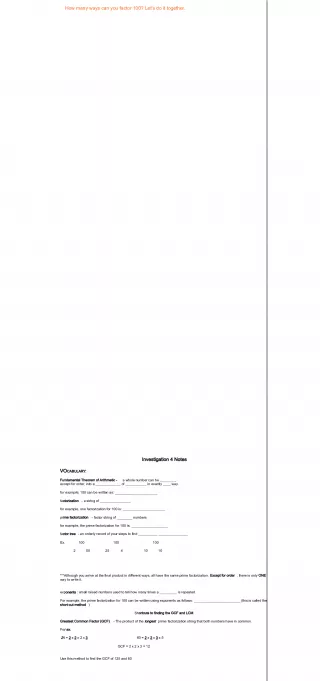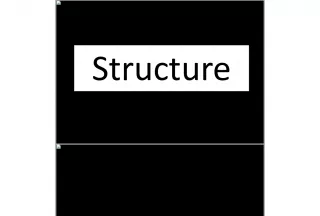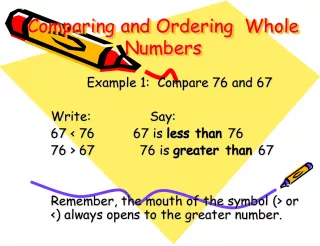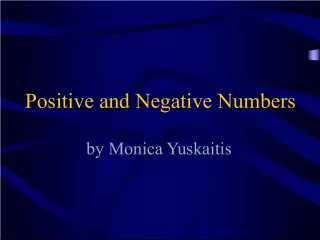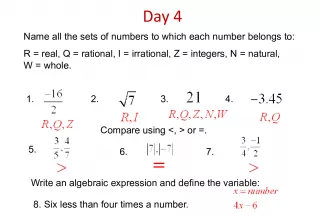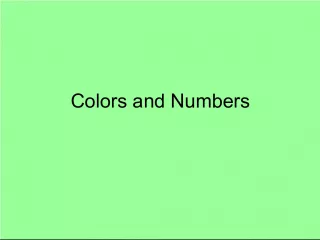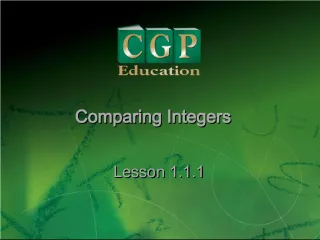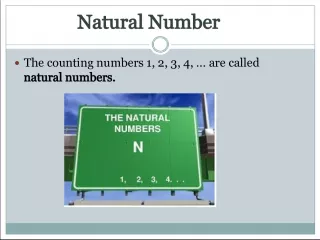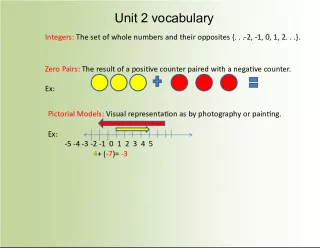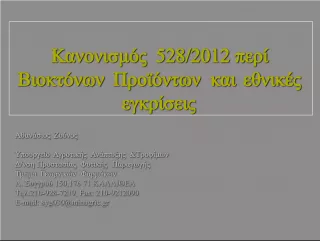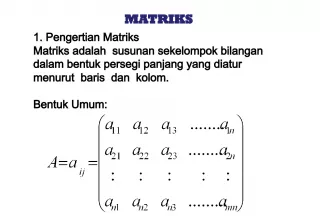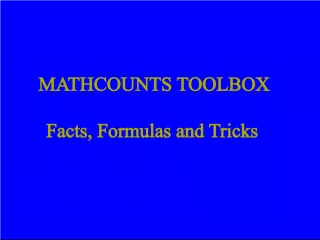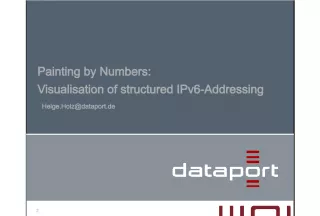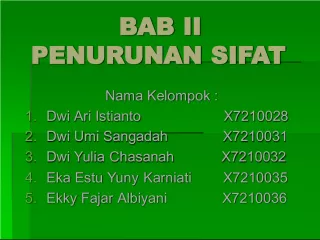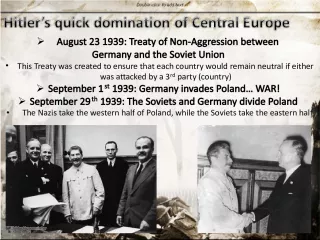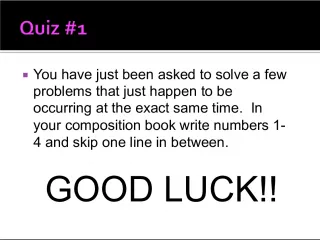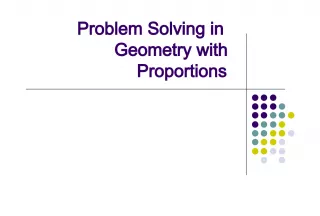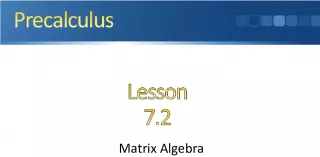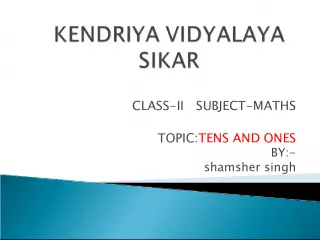Understanding Prime Numbers
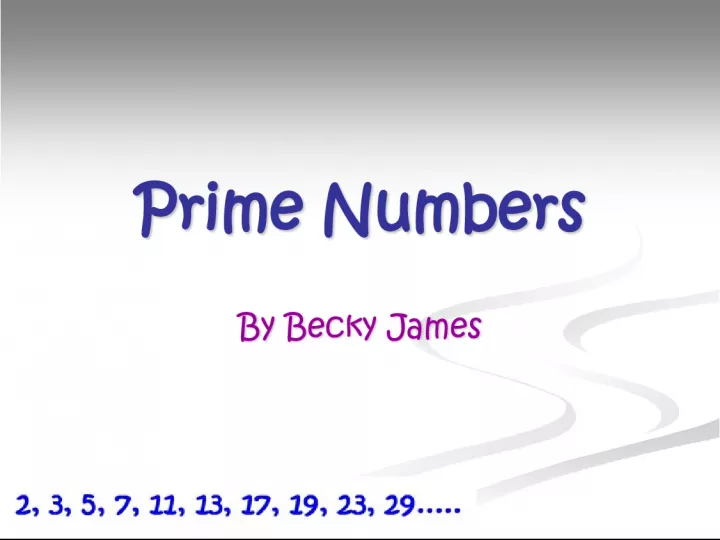

Prime numbers are numbers which have unique properties that make them important in mathematics and cryptography. Learn about them with Becky James.
- Uploaded on | 0 Views
-
 harleyking
harleyking
About Understanding Prime Numbers
PowerPoint presentation about 'Understanding Prime Numbers'. This presentation describes the topic on Prime numbers are numbers which have unique properties that make them important in mathematics and cryptography. Learn about them with Becky James.. The key topics included in this slideshow are . Download this presentation absolutely free.
Presentation Transcript
Slide1Prime Numbers Prime Numbers By Becky James By Becky James
Slide2Prime Numbers Prime Numbers Prime numbers are numbers which have no factors other than 1 and itself. The ancient Prime numbers are numbers which have no factors other than 1 and itself. The ancient Chinese discovered the primes, but didn’t really do anything with them. It was only in Chinese discovered the primes, but didn’t really do anything with them. It was only in the Golden Age of the Greeks that the mysteries behind prime numbers were the Golden Age of the Greeks that the mysteries behind prime numbers were investigated. Euclid in his Elements offered some insight into prime numbers: investigated. Euclid in his Elements offered some insight into prime numbers: If you look at the prime numbers between 1and 20… If you look at the prime numbers between 1and 20… 2, 3, 5, 7, 11, 13, 17, 19. 2, 3, 5, 7, 11, 13, 17, 19. There are 8, nearly half are prime. Between 20 and 40… There are 8, nearly half are prime. Between 20 and 40… 23, 29, 31, 37. 23, 29, 31, 37. There are 4. The number of primes is reducing, so do they eventually dwindle out to There are 4. The number of primes is reducing, so do they eventually dwindle out to nothing? In other words, are there an infinite number of prime numbers? nothing? In other words, are there an infinite number of prime numbers?
Slide3Euclid’s Proof Euclid’s Proof Let’s say there is a finite amount of prime numbers… there must be a Let’s say there is a finite amount of prime numbers… there must be a largest prime number. Call that number P. That makes our series of largest prime number. Call that number P. That makes our series of prime numbers look like this: prime numbers look like this: 2, 3, 5, 7……. P. 2, 3, 5, 7……. P. If we multiply all of those numbers together, we get…. If we multiply all of those numbers together, we get…. 2 x 3 x 5 x 7 x……. x P = N 2 x 3 x 5 x 7 x……. x P = N
Slide4Euclid’s Proof Euclid’s Proof N is the product of all the primes. N is the product of all the primes. If we now consider N + 1… If we now consider N + 1… which numbers are factors? which numbers are factors? None! 2 is the smallest factor of N, so therefore cannot be a factor of None! 2 is the smallest factor of N, so therefore cannot be a factor of N + 1. That means that N + 1 is prime, since the only other factor can be N + 1. That means that N + 1 is prime, since the only other factor can be 1. This means there is an infinite number of prime numbers. 1. This means there is an infinite number of prime numbers. The largest prime number to have been calculated has 9.1 million digits! The largest prime number to have been calculated has 9.1 million digits!
Slide5Finding Primes Finding Primes Both Fermat and Mersenne have offered us some techniques for finding Both Fermat and Mersenne have offered us some techniques for finding the prime numbers. Neither always bring up a prime number, but in the the prime numbers. Neither always bring up a prime number, but in the case of Mersenne, his formula leads to finding perfect numbers. case of Mersenne, his formula leads to finding perfect numbers. Fermat’s formula: 2 n + 1 Fermat’s formula: 2 n + 1 Mersenne’s formula: 2 n – 1 Mersenne’s formula: 2 n – 1 We don’t know whether there are an infinite number of Mersenne primes We don’t know whether there are an infinite number of Mersenne primes or whether we can achieve an infinite number of primes from Fermat’s or whether we can achieve an infinite number of primes from Fermat’s Formula. Formula.
Slide6How Many Primes? How Many Primes? Gauss noticed, as Euclid did, that the prime numbers begin to dwindle Gauss noticed, as Euclid did, that the prime numbers begin to dwindle out as we get higher and higher up the number ladder… out as we get higher and higher up the number ladder… After lots of calculating and trial and error, Gauss showed that: After lots of calculating and trial and error, Gauss showed that: Density of Primes ≈ 1/log n Density of Primes ≈ 1/log n (where n = the sample of numbers in which the primes are being counted.) (where n = the sample of numbers in which the primes are being counted.)
Slide7Uses of Prime Numbers Uses of Prime Numbers There are a number of uses of prime numbers. There are a number of uses of prime numbers. Some uses have been invented by humans for Some uses have been invented by humans for various reasons and some are so engrained in various reasons and some are so engrained in nature that it seems prime numbers play a more nature that it seems prime numbers play a more fundamental role in life than we sometimes fundamental role in life than we sometimes realise… realise…
Slide8Music of the Primes Music of the Primes Olivier Messiaen, a famous composer found a great use Olivier Messiaen, a famous composer found a great use for prime numbers in his music: for prime numbers in his music: Messiaen used both a 17 and 29 sequence in his piece of music Messiaen used both a 17 and 29 sequence in his piece of music Quartet for the End of Time . Both motifs start at the same time, however, Quartet for the End of Time . Both motifs start at the same time, however, since they are both prime numbers, the same sequence of notes playing since they are both prime numbers, the same sequence of notes playing together from each sequence wont be the same until they have played together from each sequence wont be the same until they have played through 17 x 29 times each. He held prime numbers very close to his through 17 x 29 times each. He held prime numbers very close to his heart and believed they gave his music a timelessness quality. heart and believed they gave his music a timelessness quality.
Slide9Primes In Nature Primes In Nature Similarly, the cicada, a burrowing insect Similarly, the cicada, a burrowing insect owes its survival to prime numbers and their owes its survival to prime numbers and their properties. The cicada lives underground for 17 properties. The cicada lives underground for 17 years, making no sound or showing any signs for years, making no sound or showing any signs for this amount of time. After 17 years, all of the insects this amount of time. After 17 years, all of the insects appear in the forest for just six weeks to mate before appear in the forest for just six weeks to mate before dying out. dying out.
Slide10Primes In Nature Primes In Nature This survival technique, whilst the noise drives local residents This survival technique, whilst the noise drives local residents to evacuate the area for the six weeks due to the noise, has to evacuate the area for the six weeks due to the noise, has come about due to a predator that would appear in the forest come about due to a predator that would appear in the forest at regular intervals. The cicada could avoid confrontation with at regular intervals. The cicada could avoid confrontation with the predator more often by only appearing every 17 years as the predator more often by only appearing every 17 years as the number is prime. As with Messiaen’s music, it would be a the number is prime. As with Messiaen’s music, it would be a long time before the predator and the cicada would meet long time before the predator and the cicada would meet again. again.
Slide11Prime Numbers In Code Breaking Prime Numbers In Code Breaking Prime numbers assist us more in today’s society than Prime numbers assist us more in today’s society than some people realise. Internet banking, shopping and some people realise. Internet banking, shopping and general interaction would not be secure if it wasn’t for general interaction would not be secure if it wasn’t for these interesting numbers. A particular feature of these interesting numbers. A particular feature of prime factors comes in very useful in keeping details prime factors comes in very useful in keeping details private… private…
Slide12Prime Numbers In Code Breaking Prime Numbers In Code Breaking Codes used to be kept entirely private. The Codes used to be kept entirely private. The encoded message, the key to decoding the encoded message, the key to decoding the message… everything was confidential. However, message… everything was confidential. However, today there exist a technique that allows encoded today there exist a technique that allows encoded messages and even the method to unlocking the messages and even the method to unlocking the message to be publicly announced. message to be publicly announced.
Slide13Prime Numbers In Code Breaking Prime Numbers In Code Breaking To encode a message… To encode a message… If we want to send the message “HELLO” we simply convert it into a If we want to send the message “HELLO” we simply convert it into a string of numbers: string of numbers: 0805121216 0805121216 (A=01, B=02… etc.) (A=01, B=02… etc.) We can then raise that number to a publicly announced power, divide it We can then raise that number to a publicly announced power, divide it by another number which has again been publicly announced and we by another number which has again been publicly announced and we will be left with a remainder. This is our encoded message… will be left with a remainder. This is our encoded message…
Slide14Prime Numbers In Code Breaking Prime Numbers In Code Breaking To decode this message… To decode this message… The person who received the coded string of numbers The person who received the coded string of numbers would raise that number to another power which would raise that number to another power which would only be known to them. They then divide it would only be known to them. They then divide it again by the number publicly announced earlier and again by the number publicly announced earlier and the remainder from that would be the string of the remainder from that would be the string of numbers that break down to say “HELLO”! numbers that break down to say “HELLO”!
Slide15Prime Numbers In Code Breaking Prime Numbers In Code Breaking For Example… For Example… Let our message be “E”. “E” is converted to 05, and is then Let our message be “E”. “E” is converted to 05, and is then raised to the 7 th power (this is important and will be explained raised to the 7 th power (this is important and will be explained later). Our number is now 78,125. We divide that number by later). Our number is now 78,125. We divide that number by 33 (again will be explained later) to give 2367 with a 33 (again will be explained later) to give 2367 with a remainder of 14. remainder of 14. 14 is our encoded message. 14 is our encoded message.
Slide16Prime Numbers In Code Breaking Prime Numbers In Code Breaking Now, to decode… Now, to decode… We raise 14 to the 3 rd power to give 2744. We divide We raise 14 to the 3 rd power to give 2744. We divide that number by 33 which gives 83 with a remainder of that number by 33 which gives 83 with a remainder of 5… 5… 5 is our decoded message and converts to “E”, the 5 is our decoded message and converts to “E”, the original message. original message.
Slide17Prime Numbers In Code Breaking Prime Numbers In Code Breaking 33 is the key in this code breaking scenario. There is a 33 is the key in this code breaking scenario. There is a mathematical occurrence deep within this number mathematical occurrence deep within this number concerning its prime factors, 3 and 11. concerning its prime factors, 3 and 11. If we multiply the numbers that are one less than the If we multiply the numbers that are one less than the factors and add one we get another number. So; factors and add one we get another number. So; (3-1) x (11-1) + 1 = 21 (3-1) x (11-1) + 1 = 21
Slide18Prime Numbers In Code Breaking Prime Numbers In Code Breaking We can then split the resulting number (21) into its We can then split the resulting number (21) into its prime factors, 3 and 7. prime factors, 3 and 7. Notice that these are the powers used to code and Notice that these are the powers used to code and decode the message. This procedure caries through decode the message. This procedure caries through with all numbers, no matter how big they are. This is with all numbers, no matter how big they are. This is precisely why the coding works. precisely why the coding works.
Slide19Prime Numbers In Code Breaking Prime Numbers In Code Breaking Now, splitting 33 into its prime factors isn’t really that difficult. However, imagine you were given: Now, splitting 33 into its prime factors isn’t really that difficult. However, imagine you were given: 34457638482334756487658734623864765476789475684365847568 34457638482334756487658734623864765476789475684365847568 36823764864352364238428734682736387642836482364357364329 36823764864352364238428734682736387642836482364357364329 84729037464364863483648774554768757645365078655445376545 84729037464364863483648774554768757645365078655445376545 43584385734587395790475934723984798574356765932740293874 43584385734587395790475934723984798574356765932740293874 9479487683746293479238794563475623846902374902347… 9479487683746293479238794563475623846902374902347…
Slide20Prime Numbers In Code Breaking Prime Numbers In Code Breaking Splitting that number, with hundreds of digits, into two prime factors would take even the fastest computer in the world more time to crack it than the Universe has existed. Splitting that number, with hundreds of digits, into two prime factors would take even the fastest computer in the world more time to crack it than the Universe has existed. Unless by a fluke the prime factors are found, it Unless by a fluke the prime factors are found, it simply takes far too much time to decode the simply takes far too much time to decode the messages. messages.
Slide21Prime Numbers In Code Breaking Prime Numbers In Code Breaking The numbers used as coding and decoding powers depend The numbers used as coding and decoding powers depend entirely on the technology available at the time and the entirely on the technology available at the time and the amount of time it would take a computer to factor a number. amount of time it would take a computer to factor a number. Since the messages tend to be a lot longer than “E” or Since the messages tend to be a lot longer than “E” or “HELLO” the process becomes longer and more complicated, “HELLO” the process becomes longer and more complicated, which unfortunately the finite nature of technology can which unfortunately the finite nature of technology can sometimes struggle to cope with. sometimes struggle to cope with.
Slide22Prime Numbers In Code Breaking Prime Numbers In Code Breaking However, since no-ones knows of a way of quickly factorising a number into prime factors the process is quite safe for now! However, since no-ones knows of a way of quickly factorising a number into prime factors the process is quite safe for now!
